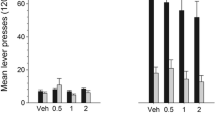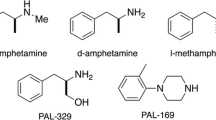Abstract
These studies were designed to evaluate the effects of the putative dopamine D3 receptor agonist 7-hydroxy-N,N-di-n-propyl-2-aminotetraline (7-OH-DPAT), alone and in combination with cocaine, in four rhesus monkeys trained to discriminate cocaine (0.4 mg/kg, IM) from saline under a fixed-ratio 30 schedule of food presentation. Under these conditions, cumulative doses of cocaine (0.013–1.3 mg/kg) produced a dose-dependent and complete generalization to the training dose of cocaine in all monkeys, while producing only minimal effects on response rates. The discriminative stimulus effects of cocaine were antagonized by the non-selective dopamine receptor antagonist flupenthixol (0.018 mg/kg, IM) in all four monkeys. The effects of 7-OH-DPAT (0.01–1.8 mg/kg) were inconsistent across monkeys. In two of the four monkeys (monkeys L990 and L958), 7-OH-DPAT consistently and completely generalized to cocaine and decreased response rates in a dose-dependent manner. Both the cocaine-like discriminative stimulus effects and rate-decreasing effects of 7-OH-DPAT were antagonized by flupenthixol in these two monkeys. Pretreatment with low doses of 7-OH-DPAT (0.01–0.032 mg/kg) had no effect on the cocaine dose-effect curve in monkeys L990 and L958; however, higher doses of 7-OH-DPAT (0.032–0.32 mg/kg) shifted the cocaine dose-effect curve to the left. In the other two monkeys (monkeys 150F and 89B036), 7-OH-DPAT produced a dose-dependent decrease in response rates but did not consistently generalize to cocaine. Flupenthixol did not antagonize the rate-decreasing effects of 7-OH-DPAT in these two monkeys, and pretreatment with 7-OH-DPAT (0.1–0.32 mg/kg) produced a decrease in response rates but had no effect on the cocaine dose-effect curve. Time-course experiments revealed that 7-OH-DPAT (0.32 mg/kg) displayed a slower onset and a longer duration of effect than the training dose of cocaine. Finally, the D3/D2 dopamine agonist quinpirole completely generalized to cocaine in three monkeys, and partially in the fourth monkey. Quinpirole showed the highest potency in those monkeys in which 7-OH-DPAT consistently generalized to cocaine. The results of the present study suggest that, in rhesus monkeys, 7-OH-DPAT produces cocaine-like effects and may modulate the discriminative stimulus effects of cocaine in some monkeys.
Similar content being viewed by others
References
Barrett RL, Appel JB (1989) Effects of stimulation and blockade of dopamine receptor subtypes on the discriminative stimulus properties of cocaine. Psychopharmacology 99:13–16
Bergman J, Kamien JB, Spealman RD (1990) Anatagonism of cocaine self-administration by selective dopamine D1 and D2 antagonists. Behav Pharmacol 1:355–363
Boundy VA, Luedtke RR, Gallitano AL, Smith JE, Filtz TM, Kallen RG, Molinoff PB (1993) Expression and characterization of the rat D3 dopamine receptor: pharmacologic properties and development of antibodies. J Pharmacol Exp Ther 264:1002–1011
Caine SB, Koob GF (1993) Modulation of cocaine self-administration in the rat through D-3 dopamine receptors. Science 260:1814–1816
Caine SB, Koob GF (1994) Effects of dopamine D-1 and D-2 anatagonists on cocaine self-administration under different schedules of reinforcement in the rat. J Pharmacol Exp Ther 270:209–217
Caine SB, Koob GF (1995) Pretreatment with the dopamine agonist 7-OH-DPAT shifts the cocaine self-administration dose-effect function to the left under different schedules in the rat. Behav Pharmacol 6:333–347
Callahan PM, Cunningham KA (1993) Discriminative stimulus properties of cocaine in relation to dopamine D2 receptor function in rats. J Pharmacol Exp Ther 266:585–592
Colpaert FC, Niemegeers CJE, Janssen PAJ (1979) Discriminative stimulus properties of cocaine: neuropharmacological characteristics as derived from stimulus generalization experiments. Pharmacol Biochem Behav 10:535–546
De Keyser J (1992) Subtypes and localization of dopamine receptors in human brain. Neurochem Int 22:83–93
De la Garza R, Johanson CE (1983) The discriminative stimulus properties of cocaine in the rhesus monkey. Pharmacol Biochem Behav 19:145–148
Diaz J, Levèsque D, Lammers CH, Griffon N, Martres MP, Schwartz JC, Sokoloff P (1995) Phenotypical characterization of neurons expressing the dopamine D3 receptor in the rat brain. Neuroscience 65:731–745
Geter-Douglass B, Alling KL, Acri JB, Witkin JM, Katz JL (1994) Characterization of the behavioral effects of (±)-7-hydroxydipropylaminotetralin (7-OH-DPAT). In: Harris LS (ed) Problems of drug dependence 1994 (NLDA Research Monograph 153). US DNHS Publication, Roekville, Md., p. 367
Gingrich JA, Caron MG (1993) Recent advances in the molecular biology of dopamine receptors. Annu Rev Neurosci 16:299–321
Hess EJ, Creese I (1987) Biochemical characterization of dopamine receptors. In: Creese I, Fraser CM (eds) Dopamine receptors. Alan R. Liss, New York, pp 1–28
Johanson CE, Fischman MW (1989) The pharmacology of cocaine related to its abuse. Pharmacol Rev 41:3–52
Johanson CE, Barrett JE (1993) The discriminative stimulus effects of cocaine in pigeons. J Pharmacol Exp Ther 267:1–8
Kenakin T (1993) Pharmacologic analysis of drug-receptor interaction, 2nd edn. Raven Press, New York
Kleven MS, Woolverton WL (1990a) The effects of continuous infusions of SCH 23390 on cocaine- or food-maintained behavior in rhesus monkeys. Behav Pharmacol 1:365–373
Kleven MS, Woolverton WL (1990b) Effects of bromocriptine and desipramine on behavior maintained by cocaine or food presentation in rhesus monkeys. Psychopharmacology 101:208–213
Kleven MS, Anthony EW, Woolverton WL (1990) Pharmacological characterization of the discriminative stimulus effects of cocaine in rhesus monkeys. J Pharmacol Exp Ther 254:312–317
Koob GF (1992) Drugs of abuse: anatomy, pharmacology and function of regard pathways. Trends Pharmacol Sci 13:177–184
Kula NS, Baldessarini RJ, Kebabian JW, Neumeyer JL (1994)S-(+)-Aporphines are not selective for human D3 dopamine receptors. Cell Mol Neurobiol 14:185–191
Kumor K, Sherer M, Jaffe J (1986) Haloperidol-induced dystonia in cocaine addicts. Lancet ii: 1341–1342
Lamas X, Negus SS, Hall E, Mello NK (1995) Relationship between the discriminative stimulus effects and plasma concentrations of intramuscular cocaine in rhesus monkeys. Psychopharmacology 121:331–338
Lévesque D, Diaz J, Pilon C, Martres MP, Giros B, Souil E, Schott M, Morgat JL, Schwatrz JC, Sokoloff P (1992) Identification, characterization, and localization of the dopamine D3 receptor in rat brain using 7-[3H]-hydroxy-N,N-di-n-propyl-2-aminotetralin. Proc Natl Acad Sci USA 89:8155–8159
Liu JC, Cox RF, Greif GJ, Freedman JE, Waszczak BL (1993) Electrophysiologic effects of 7-OH-DPAT on nigrostriatal vs. mesolimbic dopamine systems. Soc Neurosci Abstr 19:1374
MacKenzie RG, VanLeeuwen D, Pugsley TA, Shih YH, Demettos S, Tang L, Todd RD, O'Malley KL (1994) Characterization of the human dopamine D3 receptor expressed in transfected cell lines. Eur J Pharmacol 266:79–85
Mello NK, Negus SS, Lukas SE, Mendelson JH, Sholar JW and Drieze J (1995) A primate model of polydrug abuse: cocaine and heroin combinations, J Pharmacol Exp Ther 274:1325–1337
Möller-Nielson I, Pederson V, Nymark M, Franck KF, Bobeck V, Fjalland B, Christensen AV (1973) The comparative pharmacology of flupenthixol and some reference neuroleptics. Acta Pharmacol Toxicol 33:353–363
Nader MA, Mach RH (1996) Self-administration of the dopamine D3 agonist 7-OH-DPAT in rhesus monkeys is modified by previous cocaine exposure. Psychopharmacology (in press)
Negus SS, Mello NK, Portoghese PS, Lukas SE, Mendelson JH (1995) Role of delta opioid receptors in the reinforcing and discriminative stimulus effects of cocaine in rhesus monkeys. J Pharmacol Exp Ther 273:1245–1256
Nielsen EB (1993) Regulation of drug discrimination behaviour by dopamine D1 and D2 receptors. In: Waddington JL (ed) D1:D2 dopamine receptor interactions. Academic Press, London, pp 159–173
Oliveto AH, Rosen MI, Woods SW, Kosten TR (1995) Discriminative stimulus, self-reported and cardiovascular effects of orally administered cocaine in humans. J Pharmacol Exp Ther 272:231–241
Potenza MN, Graminski GF, Schmauss C, Lerner MR (1994) Functional expression and characterization of human D2 and D3 dopamine receptors. J Neurosci 14:1463–1476
Ritz MC, Lamb RJ, Goldberg SR, Kuhar MJ (1987) Cocaine receptors in dopamine transporters are related to self-administration of cocaine. Science 237:1219–1223
Schwartz JC, Giros B, Martres MP, Sokoloff P (1992) The dopamine receptor family: molecular biology and pharmacology. Semin Neurosci 4:99–108
Skjoldager P, Winger G, Woods JH (1993) Effects of GBR 12909 and cocaine on cocaine-maintained behavior in rhesus monkeys. Drug Alcohol Depend 33:31–39
Sokoloff P, Giros B, Martres MP, Bouthenet ML, Schwartz JC (1990) Molecular cloning and characterization of a novel dopamine receptor (D3) as a target for neuroleptics. Nature 347:146–151
Spealman RD (1994) Dopamine D3 receptor agonists partially reproduce the discriminative stimulus effects of cocaine. Soc Neurosci Abstr 20:1630
Spealman RD, Bergman J, Madras BK, Melia KF (1991) Discriminative stimulus effects of cocaine in squirrel monkeys: involvement of dopamine receptor subtypes. J Pharmacol Exp Ther 258:945–953
Terry P, Witkin JM, Katz JL (1994) Pharmacological characterization of the novel discriminative stimulus effects of a low dose of cocaine. J Pharmacol Exp Ther 270:1041–1048
Weed MR, Vanover KE, Woolverton WL (1993) Reinforcing effects of the D1 dopamine agonist SKF81297 in rhesus monkeys. Psychopharmacology 113:51–52
Winger G (1994) Dopamine antagonist effects of behavior maintained by cocaine and alfentanil in rhesus monkeys. Behav Pharmacol 5:141–152
Witkin JM, Nichols DE, Terry P, Katz JL (1991) Behavioral effects of selective dopaminergic compounds in rats discriminating cocaine injections. J Pharmacol Exp Ther 257:706–713
Wood DM, Emmett-Oglesby MW (1989) Mediation in the nucleus accumbens of the discriminative stimulus produced by cocaine. Pharmacol Biochem Behav 33:453–457
Woods JW, Winger GW, France CP (1987) Reinforcing and discriminative stimulus effects of cocaine: analysis of pharmacological mechanisms. In: Fisher S, Raskin A, Uhlenhut EH (eds) Cocaine: clinical and biobehavioural aspects. Oxford University Press, New York, pp 21–65
Woolverton WL (1991) Discriminative stimulus effects of cocaine. In: Glennon RA, Järbe TUC, Frankenheim J (eds) Drug discrimination: applications to drug abuse research (NIDA Research Monograph 116). US DHHS Publication, Rockville, Md., pp 61–74
Woolverton WL, Goldberg LI and Ginos JZ (1984) Intravenous self-administration of dopamine receptor agonists by rhesus monkeys. J Pharmacol Exp Ther 230:678–683
Author information
Authors and Affiliations
Additional information
This paper is dedicated to the memory of Xavier Lamas, who died on 26 August 1995 on Mount Everest
Rights and permissions
About this article
Cite this article
Lamas, X., Negus, S.S., Mello, N.K. et al. Effects of the putative dopamine D3 receptor agonist 7-OH-DPAT in rhesus monkeys trained to discriminate cocaine from saline. Psychopharmacology 124, 306–314 (1996). https://doi.org/10.1007/BF02247435
Received:
Revised:
Issue Date:
DOI: https://doi.org/10.1007/BF02247435




